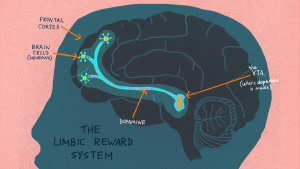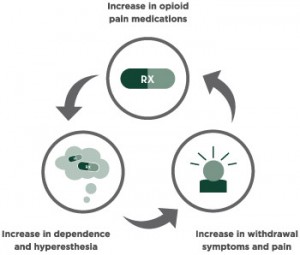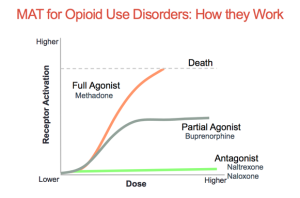Opioid addiction is a major problem in the US. According to the CDC overdose deaths involving opioids have increased by over 8 times since 1999. In 2020 an estimated 69,000 people died of opioid overdose. The start of these addictions can vary, often it starts with a prescription for opioids as a pain relief, and will spiral from there into a serious problem.
https://www.cdc.gov/opioids/data/index.html
What is Addiction?

All drugs with potential for addiction work by activating the brains natural reward system, and eventually will rewire that reward system to be preferential to the drug of choice. The mesolimbic dopamine pathway has long been regarded as the reward pathway, and is what is most affected during addiction. Drugs will activate dopamine neurons in this pathway, and with enough use the circuit will adapt to these levels of activation. This adaptation will make natural rewards (food, sex, social interaction, etc.) less rewarding, and the person will seek drug use in order to feel a reward.
Effects of Addiction
With addiction and the changes in the reward pathway comes with it comes something called tolerance and withdrawal. Tolerance in defined as “reduce response to a drug with repeated use” by the CDC. With chronic drug use, over time the brain will adapt its reward system to the amount of drug being taken, and less of an effect will occur. With a dysfunctional reward system a person is driven to take a larger amount of their drug of choice in order to feel a reward, since natural rewards are no longer creating that effect in the brain. Withdrawal is the effects that are felt when there is no drug of choice in the body. Typically the symptoms are opposite of the ‘high’ that the drug causes. Withdrawal often drives people to continue taking the drug, and further the addiction.

How Do We Treat Addiction?
There’s a few ways to go about treating addiction, and often multiple different methods are used together to create an effective plan. Therapy is the most common, to treat the psychological factors of addiction. It is often used with medications to treat the biological factors of addiction discussed above. Medications to treat opioid addiction bind to the same receptors that opioids do in the brain, which can have a few benefits. First it blocks opioids from binding and causing dopamine activation in the reward system. Secondly, binding to these receptors can have relieving effects for cravings and symptoms of withdrawal from opioids. Since they bind to the same receptors, they produce the same effects in the brain.
But wait, isn’t that a bad thing?

Yes and no. It’s not ideal since this is what leads to these medications to also have potential for abuse and addiction. However there are benefits to these medications that make them effective at treating addiction. There are 3 medications that are currently FDA approved: methadone, buprenorphine, and naloxone.
https://www.fda.gov/drugs/information-drug-class/information-about-medication-assisted-treatment-mat
Methadone:
This medication is not used very commonly anymore as it is a full receptor agonist, meaning it produces an effect just as strong as opioids. As you can imagine this is not ideal, and is also highly addictive. The benefit to methadone compared to opioids is that people developed a tolerance to methadone much slower, and the detoxification process from it seemed to be less harsh compared to opioids.
Buprenorphine:
This medication is often prescribed as a combination tablet or dissolvable film with naloxone. It is much more commonly used to relieve cravings and withdrawal symptoms, as it is a partial agonist to the opioid receptor. This means it produces a much weaker effect compared to opioids when bound to the receptor. This makes it less addictive, though there is still a slight potential for abuse. Overdose of buprenorphine is also very difficult to happen and rare to occur, as the drug produces a much smaller effect.
Naloxone:
The third FDA approved drug to treat addiction, and it works in the opposite way that buprenorphine and methadone. Naloxone is an opioid receptor antagonist, meaning when it’s bound it produces the opposite effect, or it stops the effect or opioids. It is used mainly as an antidote for opioid overdose, as it will flood the brain and block all opioid receptors to stop the drug from having an effect.
